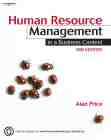Bestselling Books
|
Bestselling Books |
|
| US Bestsellers UK Bestsellers France - Meilleurs Ventes Canada Bestsellers Germany Bestsellers |
 Hooked on books? BestBooks.biz features book-related articles, book extracts and book selections from the best books - past and present. |
The Harvard Map of HRMAdapted from Human Resource Management in a Business Context, 3rd edition (2007) Beer et al (Managing Human Assets by Michael Beer, Richard E. Walton, Bert A. Spector, 1984) argue that when general managers determine the appropriate human resource policies and practices for their organizations, they require some method of assessing the appropriateness or effectiveness of those policies. Beer et al devised the famous Harvard Map (sometimes referred to as the Harvard model) of HRM. This map is based on an analytical approach and provides a broad causal depiction of the 'determinants and consequences of HRM policies.' It shows human resource policies to be influenced by two significant considerations:
The authors also contend that human resource policies have both immediate organizational outcomes and long-term consequences. Managers can affect a number of factors by means of the policy choices they make, including: - the overall competence of employees,
Beer et al state that these 'four Cs' do not represent all the criteria that human resource policy makers can use to evaluate the effectiveness of human resource management, but consider them to be 'reasonably comprehensive' although they suggest that readers may add additional factors depending on circumstances. And various authors have done so. Beer et al argue that: "In the long run, striving to enhance all four Cs will lead to favorable consequences for individual well-being, societal well-being, and organizational effectiveness (i.e., long-term consequences). By organizational effectiveness we mean the capacity of the organization to be responsive and adaptive to its environment. We are suggesting, then, that human resource management has much broader consequences than simply last quarter's profits or last year's return on equity. Indeed, such short-term measures are relatively unaffected by HRM policies. Thus HRM policy formulation must incorporate this long-term perspective." This article is based on Human Resource Management in a Business Context by Alan Price (3rd edition, 2007) |
 in a Business Context by Alan Price
|
|
|
|
|
|
|
|
|
| Copyright © 2000-20l7 Alan Price and BestBooks.biz contributors. All rights reserved. |